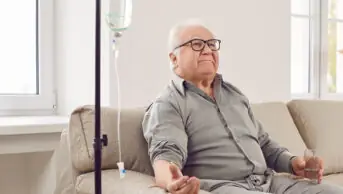
Sam Ogden / Science Photo Library
Summary
Lymphoma treatment approaches are broadly similar and based on combination chemotherapy, radiotherapy and stem cell transplants. Hodgkin lymphoma is usually treated with the ABVD schedule first, with BEAM and autologous stem cell transplant second line. Aggressive non-Hodgkin lymphoma is often treated with the R-CHOP schedule.
Cancer learning ‘hub’
Pharmacists are playing an increasingly important role in supporting patients with cancer, working within multidisciplinary teams and improving outcomes. However, in a rapidly evolving field with numbers of new cancer medicines is increasing and the potential for adverse effects, it is now more important than ever for pharmacists to have a solid understanding of the principles of cancer biology, its diagnosis and approaches to treatment and prevention. This new collection of cancer content, brought to you in partnership with BeOne Medicines, provides access to educational resources that support professional development for improved patientClassic Hodgkin lymphoma
Chemotherapy with doxorubicin, bleomycin, vinblastine and dacarbazine (ABVD) has been the cornerstone of treatment for all stages of classic Hodgkin lymphoma for the past 30 years (see ‘Common chemotherapy schedules for Hodgkin lymphoma’)[1] . This is followed, in some instances, by localised radiotherapy.| Common chemotherapy schedules for Hodgkin lymphoma | |||
|---|---|---|---|
| ABVD (repeated every 28 days) | |||
| Doxorubicin (adriamycin) | 25mg/m2 | i.v. | Days 1 + 15 |
| Bleomycin | 10mg/m2 | i.v. | Days 1 + 15 |
| Vinblastine | 6mg/m2 | i.v. | Days 1 + 15 |
| Dacarbazine | 375mg/m2 | i.v. | Days 1 + 15 |
| Escalated BEACOPP (repeated every 21 days) | |||
| Bleomycin | 10mg/m2 | i.v. | Day 8 |
| Etoposide | 200mg/m2 | i.v. | Days 1–3 |
| Doxorubicin (adriamycin) | 35mg/m2 | i.v. | Day 1 |
| Cyclophosphamide | 1,250mg/m2 | i.v. | Day 1 |
| Vincristine (Oncovin) | 1.4mg/m2 (maximum: 2mg) | i.v. | Day 8 |
| Procarbazine | 100mg/m2 | p.o. | Days 1–7 |
| Prednisolone | 40mg/m2 | p.o. | Days 1–14 |
| G-CSF | s.c. | From day 8 | |
| BEAM | |||
| Carmustine (BiCNU) | 300mg/m2 | i.v. | Day 1 |
| Etoposide | 200mg/m2 | i.v. | Days 2–5 |
| Cytarabine (Ara-C) | 200mg/m2 bd | i.v. | Days 2–5 |
| Melphalan | 140mg/m2 | i.v. | Day 6 |
PET scans
The RATHL study, which is based in the UK, is currently investigating the role of interim positron emission tomography (PET) scans as a means of assessing patients’ risk of relapse and tailoring treatments accordingly. The study involves patients with intermediate or advanced stage Hodgkin lymphoma who received a PET scan after two cycles of ABVD chemotherapy. Patients with a negative scan have been randomised to a further four cycles of ABVD or four cycles of AVD (omitting the bleomycin, which is known to be associated with long-term lung toxicity). Patients with a positive PET scan have been switched to a BEACOPP regimen. To date the study has not published its findings.Nodular lymphocyte predominant Hodgkin lymphoma
Nodular lymphocyte predominant Hodgkin lymphoma (NLPHL) is a rarer subtype of the disease but is managed in a broadly similar way to classic Hodgkin lymphoma[1] . Ann Arbor stage 1 disease is usually treated with excision or radiotherapy alone. Malignant cells express the CD20 antigen in NLPHL, and rituximab, an anti-CD20 monoclonal antibody, can be given alone or in combination with standard chemotherapy as a first-line or second-line treatment. Importantly, NLPHL cells do not express CD30, so brentuximab is not used.Aggressive non-Hodgkin lymphoma
The aim of treatment in aggressive forms of non-Hodgkin lymphoma, such as diffuse large B cell lymphoma (DLBCL), is to cure the patient. Treatment is tailored to the patient, taking into account their age, co-morbidities and any risk factors. It usually involves six to eight cycles of R-CHOP chemotherapy, which adds rituximab to the CHOP schedule developed in the 1970s (see ‘Common chemotherapy schedules for non-Hodgkin lymphoma’) and has shown improved response rates compared with CHOP alone[9] ,[10] . For example, a large French study of 399 patients aged 60–80 years demonstrated that the addition of rituximab to CHOP significantly improved five-year survival rates from 45% to 58%[10] .| Common chemotherapy schedules for non-Hodgkin lymphoma | |||
|---|---|---|---|
| R-CHOP (repeated every 21 days) | |||
| Rituximab | 375mg/m2 | i.v. | Day 1 |
| Cyclophosphamide | 750mg/m2 | i.v. | Day 1 |
| Doxorubicin (hydroxydaunomycin) | 50mg/m2 | i.v. | Day 1 |
| Vincristine (Oncovin) | 1.4mg/m2 (maximum: 2mg) | i.v. | Day 1 |
| Prednisolone | 100mg | p.o. | Days 1-5 |
| R-CVP (repeated every 21 days) | |||
| Rituximab | 375mg/m2 | i.v. | Day 1 |
| Cyclophosphamide | 750mg/m2 | i.v. | Day 1 |
| Vincristine | 1.4mg/m2 (maximum: 2mg) | i.v. | Day 1 |
| Prednisolone | 100mg | p.o. | Days 1-5 |
| R-bendamustine (repeated every 28 days) | |||
| Rituximab | 375mg/m2 | i.v. | Day 1 |
| Bendamustine | 90mg/m2 | i.v. | Days 1-2 |
| FCR (repeated every 28 days) | |||
| Fludarabine | 24mg/m2 | p.o. | Days 1-5 |
| Cyclophosphamide | 150mg/m2 | p.o. | Day 1-5 |
| Rituximab | 375mg/m2 | i.v. | Day 1 |
Follicular lymphoma
Follicular lymphoma often presents asymptomatically and does not always require immediate treatment. Treatment is usually reserved until the patient becomes symptomatic, which occurs a median of 2.5 years after diagnosis, but can be more than 10 years. There is currently no evidence that survival is improved by early initiation of treatment in asymptomatic patients[15] . However, treatment with rituximab at diagnosis is currently being evaluated in clinical trials and, although it has yet to demonstrate an overall survival benefit, it does appear to improve progression-free survival rates[16] . Patients who present with limited disease can be treated with radiotherapy alone, which may cure the lymphoma. Symptomatic patients with more advanced disease are treated with chemotherapy and rituximab, which aims to prolong survival. Commonly used regimens include R-CHOP, R-CVP, FCR and R-bendamustine (see ‘Common chemotherapy schedules for non-Hodgkin lymphoma’). R-bendamustine is increasingly being used as the combination schedule of choice. A recent head-to-head study comparing R-bendamustine with R-CHOP found R-bendamustine had better efficacy (median progression-free survival 69.5 months compared with 31.2 months) and tolerability[17] . The latest European follicular lymphoma guidelines recommend schedules including fludarabine should not be used, as it has been found to increase rates of haematological toxicity[15] . There is strong evidence that rituximab, given every two to three months as a maintenance therapy, improves progression-free survival (and possibly overall survival) in patients who respond to first-line treatment and who have received treatment for relapsed disease[18] . Although it is relatively well tolerated, clinical trials have demonstrated that rituximab maintenance therapy is associated with significantly higher rates of infection when compared with control groups. It is unclear whether ASCT should be used in preference to rituximab maintenance therapy in follicular lymphoma. Younger, fitter patients may be considered for an allogeneic stem cell transplant using reduced intensity conditioning, as this is the only potentially curative option for this form of non-Hodgkin lymphoma.Burkitt’s lymphoma
Historically, Burkitt’s lymphoma had a very poor prognosis. However, intensive inpatient chemotherapy regimens such as CODOX-M/IVAC (commonly with rituximab), outcomes have improved considerably[19] . Patients with Burkitt’s lymphoma are at very high risk of tumour lysis syndrome. This is a medical emergency that occurs when chemotherapy causes large numbers of tumour cells to die over a short period. These cells release their cellular contents, leading to complications such as hyperkalaemia, hyperphosphataemia, hyperuricaemia, hypocalcaemia, acute uric acid nephropathy and acute renal failure. Although allopurinol is usually used to reduce the risk of tumour lysis syndrome, it is unlikely to be effective in patients with Burkitt’s lymphoma due to the very high number of cells killed, and intravenous rasburicase (0.2mg/kg/day for 5–7 days) is used instead. R-CODOX-M/IVAC, a schedule that alternates rituximab, cyclophosphamide, vincristine, doxorubicin and methotrexate with a regimen including rituximab, etoposide, ifosfamide and cytarabine, can be considered for patients with diffuse large B cell lymphoma who have very high IPI scores (see accompanying article) and require a more intensive chemotherapy schedule than R-CHOP.Mantle cell lymphoma
Mantle cell lymphoma is an indolent lymphoma but has a five-year survival rate of around 30% and is treated in a similar fashion to the more aggressive lymphoma subtypes. The current gold standard for younger, fitter patients is a schedule of alternating R-MaxiCHOP (R-CHOP with cyclophosphamide 1,200mg/m2 and doxorubicin 75 mg/m2) and high dose cytarabine (the so-called ‘Nordic schedule’) followed by ASCT. The 10-year survival rate for patients treated with this regimen — which has only recently been introduced in the UK — is 58%, and overall survival rates for mantle cell lymphoma are likely to improve with time[20] . Another emerging option in patients with mantle cell lymphoma is the FCR (fludarabine, cyclophosphamide and rituximab) schedule, which has a better response rate and improved overall survival rate compared with fludarabine and cyclophosphamide alone[21] .New developments in non-Hodgkin lymphoma
Subcutaneous rituximab is licensed in the UK for the treatment of patients with follicular lymphoma and diffuse large B cell lymphoma. All patients must have received at least one previous dose of intravenous rituximab. It is given as a 1,400mg dose and, as it requires 11.7ml to be injected, is formulated with hyaluronidase to aid administration. A recent NHS England Specialised Services Circular (SSC1434) stipulated that subcutaneous rituximab will only be funded for maintenance therapy and not if used in combination with chemotherapy. Pixantrone is an anthracenedione analogue similar to mitoxantrone, and has been approved by NICE as a third-line or fourth-line monotherapy for treating repeatedly relapsed or refractory aggressive non-Hodgkin lymphoma[22] . This recommendation is based on results of an international phase III trial, which found improved response rates and progression-free survival (and a trend towards increased overall survival rates) when pixantrone was compared with standard therapy[23] . Pixantrone is given intravenously at a dose of 50mg/m2 on Days 1, 8 and 15 of each 28-day cycle for up to 6 cycles. It is less cardiotoxic than mitoxantrone, although the manufacturer recommends that left ventricular ejection fraction (LVEF) is monitored. Ibrutinib , a novel oral Bruton’s tyrosine kinase (BTK) inhibitor, has received initial authorisation from the European Medicines Agency (EMA) for the treatment of both chronic lymphocytic leukaemia and relapsed or refractory mantle cell lymphoma. BTK is a cytoplasmic enzyme that is a key component of a signalling pathway essential for cell maturation, proliferation and survival of B cells. By inhibiting the phosphorylation of this BTK, ibrutinib blocks this pathway and induces apoptosis. A recent phase II trial using ibrutinib 560mg daily in 115 patients with relapsed or refractory mantle cell lymphoma found a 68% response rate and a median progression-free survival of 14 months[24] . The drug appears to be well tolerated, and the most common adverse effects are diarrhoea and fatigue. Idelalisib has received initial authorisation from the EMA. Idelalisib inhibits the enzyme phosphoinositide 3-kinase, which is a key intermediary in B cell signalling pathways. It is indicated as a first-line or second-line treatment (in combination with rituximab) for chronic lymphocytic leukaemia, and as monotherapy for relapsed follicular lymphoma. A phase II study of idelalisib 150mg twice daily in 72 patients with follicular lymphoma, who had received at least two prior lines of therapy, found 54% of patients responded to treatment, with a median duration of response of more than 12 months[25] .References
[1] Eichenauer DA, Engert A, André M et al. Hodgkin’s lymphoma: ESMO Clinical Practice Guidelines for diagnosis, treatment and follow-up. Ann Oncol 2014;25(suppl 3): iii70–iii75
[2] Engert A, Plutschow A, Eich HT et al. Reduced treatment intensity in patients with early-stage Hodgkin’s lymphoma. New Engl J Med 2010; 363: 640–662
[3] von Tresckow B, Plütschow A, Fuchs M et al . Dose-intensification in early unfavorable Hodgkin’s lymphoma: final analysis of the German Hodgkin Study Group HD14 trial. J Clin Oncol 2012;30:907–913.
[4] Skoetz N, Trelle S, Rancea M et al. Effect of initial treatment strategy on survival of patients with advanced-stage Hodgkin’s lymphoma: a systematic review and network meta-analysis. Lancet Oncol 2013;14:943–952
[5] Follows GA, Ardeshna KM, Barrington SF et al. Guidelines for the first line management of classical Hodgkin lymphoma. Brit J Haematol 2014;166: 34–49.
[6] Linch DC, Winfield D, Goldstone AH et al. Dose intensification with autologous bone-marrow transplantation in relapsed and resistant Hodgkin’s disease: results of a BNLI randomised trial. Lancet 1993;341:1051–1054.
[7] Younes A, Gopal AK, Smith SE et al. Results of a pivotal phase II study of brentuximab vedotin for patients with relapsed or refractory Hodgkin’s lymphoma. J Clin Oncol 2012;30:2183–2189
[8] Batlevi CL, Younes A. Novel therapy for Hodgkin lymphoma. Hematology American Society Hematology Education Program 2013 2013:394–399
[9] Pfreundschuh M, Kuhnt E, Trümper L et al. CHOP-like chemotherapy with or without rituximab in young patients with good-prognosis diffuse large-B-cell lymphoma: 6-year results of an open-label randomised study of the MabThera International Trial (MInT) Group. Lancet Oncol 2011;12:1013–1022.
[10] Feugier P, Van Hoof A, Sebban C et al. Long-term results of the R-CHOP study in the treatment of elderly patients with diffuse large B-cell lymphoma: a study by the Groupe d’Etude des Lymphomes de l’Adulte. J Clin Oncol 2005;23:4117–4126.
[11] Cunningham D, Hawkes EA, Jack A et al. Rituximab plus cyclophosphamide, doxorubicin, vincristine, and prednisolone in patients with newly diagnosed diffuse large B-cell non-Hodgkin lymphoma: a phase 3 comparison of dose intensification with 14-day versus 21-day cycles. Lancet 2013;381:1817–1826.
[12] Tilly H, Vitolo U, Walewski J et al. Diffuse Large B-Cell Lymphoma: ESMO Clinical Practice Guidelines. Ann Oncol 2012;23 (Suppl 7): vii78–vii82.
[13] Wilson WH, Jung SH, Porcu P et al. A Cancer and Leukemia Group B multi-center study of DA-EPOCH-rituximab in untreated diffuse large B-cell lymphoma with analysis of outcome by molecular subtype. Haematologica 2012;97:758–765.
[14] El Gnaoui T, Dupuis J, Belhadj K et al. Rituximab, gemcitabine and oxaliplatin: an effective salvage regimen for patients with relapsed or refractory B-cell lymphoma not candidates for high-dose therapy. Ann Oncol 2007;18:1363–1368.
[15] Dreyling M, Ghielmini M, Marcus R et al. Newly Diagnosed and Relapsed Follicular Lymphoma: ESMO Clinical Practice Guidelines. Ann Oncol 2014; 25 (suppl 3): iii76–iii82
[16] Ardeshna KM, Qian W, Smith P et al. Rituximab versus a watch-and-wait approach in patients with advanced-stage, asymptomatic, non-bulky follicular lymphoma: an open-label randomised phase 3 trial. Lancet Oncol 2014;15:424–435.
[17] Rummel M, Niederle N, Maschmeyer G et al. Bendamustine plus rituximab versus CHOP plus rituximab as first-line treatment for patients with indolent and mantlecell lymphoma: an open-label, multicentre, randomised, phase 3 non-inferiority trial. Lancet 2013;381:1203–1210.
[18] Vidal L, Gafter-Gvili A, Salles G et al. Rituximab maintenance for the treatment of patients with follicular lymphoma: an updated systematic review and meta-analysis of randomized trials. J Nat Cancer Instit 2011;103:1799–1806.
[19] Mead GM, Sydes MR, Walewski J et al. An international evaluation of CODOX-M and CODOX-M alternating with IVAC in adult Burkitt’s lymphoma: results of United Kingdom Lymphoma Group LY06 study. Ann Oncol 2002;13:1264–1274.
[20] Geisler CH, Kolstad A, Laurell A et al. Nordic MCL2 trial update: six-year follow-up after intensive immunochemotherapy for untreated mantle cell lymphoma followed by BEAM or BEAC + autologous stem-cell support: still very long survival but late relapses do occur. Br J Haematol 2012;158:355–362.
[21] Rule S, Smith P, Johnnson PW et al. The Addition of Rituximab to Fludarabine and Cyclophosphamide (FC) Improves Overall Survival in Newly Diagnosed Mantle Cell Lymphoma (MCL): Results of the Randomised UK National Cancer Research Institute (NCRI) Trial. Blood (ASH Annual Meeting Abstracts) 2011;118:abstract 440.
[22] National Institute for Health and Care Excellence. Pixantrone monotherapy for treating multiply relapsed or refractory aggressive non-Hodgkin’s B-cell lymphoma. London: NICE 2014
[23] Pettengell R, Coiffier B, Narayanan G et al. Pixantrone dimaleate versus other chemotherapeutic agents as a single-agent salvage treatment in patients with relapsed or refractory aggressive non-Hodgkin lymphoma: a phase 3, multicentre, open-label, randomised trial. Lancet Oncol 2012;13:696–706.
[24] Wang ML, Rule S, Martin P et al. Targeting BTK with ibrutinib in relapsed or refractory mantle-cell lymphoma. New Engl J Med 2013;369:507–516.
[25] Gopal AK, Kahl BS, de Vos S et al. PI3Kδ inhibition by idelalisib in patients with relapsed indolent lymphoma. New Engl J Med 2014;370:1008–1018.


